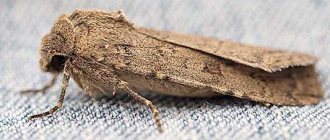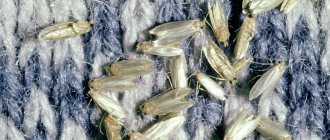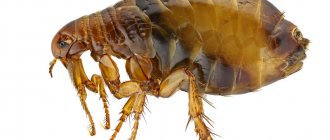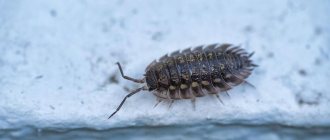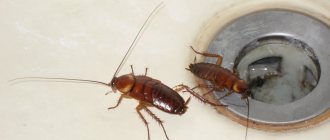Surely each of us at least once in our lives was puzzled by the following question: “Where do moths come from in a house/apartment?” Believe me, even in the cleanest and most well-groomed homes, such a problem may well arise, and the appearance of a small flying pest in clothing or even food can cause not only moral, but even material damage.
Today we invite you to talk about what moths are, find out answers to your pressing questions (how to get rid of moths), and also consider the main reasons for the appearance of such a pest on your legal territory.
Where do moths come from in an apartment?
These insects appear in homes in different ways. The method of their appearance depends on whether they infect food or clothing.
food moth
Insect larvae can feed on a variety of foods, including:
- flour;
- grains (oats, barley, wheat);
- oat and corn flakes;
- bakery products;
- pasta;
- sugar;
- seeds;
- nuts;
- cereals (buckwheat, corn, semolina, rice);
- dried fruits, etc.
It is believed that different types of moths are able to absorb only one particular food. In practice, any insect eats any food. Food black moths are not capable of ruining clothes. This is due to the fact that its digestive juices contain enzymes that cannot digest tissue fibers.
Clothes parasites
Moth larvae and eggs can get into your closet even with new clothes purchased from large stores. The sources of damage are woolen products and upholstered furniture, the upholstery of which is made of natural materials. The risk of moths entering the closet increases if worn items are purchased. The insect destroys the following clothing:
- knitwear;
- fur-lined shoes;
- cashmere, leather and cotton clothes;
- furniture upholstery;
- woolen products;
- sheepskin coats and fur coats based on natural fur;
- carpets;
- felt boots;
- bedding based on natural materials.
Moths can destroy any natural fabric. If the synthetic material contains a small amount of wool or cotton, the insect can damage it too. The pest prefers to eat clothes that have particles of epidermis or sweat on them. In order to save the fabric, people often wrap it in cellophane film, but the insect has no problem chewing through it.
What is
A moth is an insect belonging to the order of butterflies. The size and appearance of an individual depends on its species. House moths usually include clothes moths, furniture moths, grain moths and food moths. All of their adult representatives are small in size (up to 15 mm) and unsightly in color, for example, gray-green, dirty brown. The insect lives not only indoors, but also in nature. For example, there are cabbage, apple, and rye moths.
The feeding method of individuals also varies greatly. All larvae and caterpillars, thanks to their powerful mouthparts, can eat tough and hard food: stems and leaves, nuts, cereals, cabbage, beets. All moth species have their own favorite food, and it is often reflected in the name of the species. In addition, in some varieties, the adult does not have a mouthpart and cannot feed, and therefore lives no more than a week.
These pests live near or directly in a food source, for example, in cereals, cabbage, or on an apple tree. At first, a small nest always appears, where all the larvae live compactly. Nests are also within reach of food.
Life cycle of a moth
The points in the life cycle of this pest are in many ways similar to those of other insects. The moth goes through 4 stages in its development:
- egg;
- larva (caterpillar);
- chrysalis;
- imago (adult insect).
An adult female lays eggs, the number of which varies from 40 to 250. Their size is 0.3-0.5 mm. Eggs can either be concentrated at one point or distributed over the surface of any area.
After 1.5-2 weeks, translucent white larvae (caterpillars) 1 mm in length gradually hatch from the eggs. They begin to feed intensively and form a spindle-shaped cocoon. They use the nutrients located around them as material for this. Inside the cocoon their transformation into a pupa will take place. At this stage, the moth causes the most severe harm to humans.
After 35-50 days the larva begins to pupate. The pupa reaches a length of 4-7 mm. During its development, the pupa changes color. It starts out creamy white but gradually becomes more typical of a moth. This stage can last from a week to a month, after which the insect turns into a butterfly.
On the 3-4th day of life of an adult full-fledged individual, the female begins to lay eggs. Once this process is complete, she lives for about 1-4 weeks and then dies.
How long does he live?
Under normal conditions, in the absence of external factors, the duration of the full development cycle of a moth from the egg stage to the butterfly varies from 35 days to 2.5 years. At home, the insect often dies earlier if the owners use pesticides or folk remedies to combat it.
How does it reproduce?
Reproduction of moths occurs sexually with the participation of a male and a female. Egg laying is most often carried out in a place where future larvae will feed. The process of reproducing new insects most often begins immediately after the moth has taken the form of a butterfly.
At room temperature, moths reproduce year-round. In 1 year, 2-5 generations of the pest can develop.
How is it distributed?
The reasons for the appearance of moths in an apartment vary, but most often they involve improper storage of food in stores or warehouses. Food may be contaminated before it is even packaged. This can also happen if the seal of the package has been broken. When purchasing food at various sales, the risk of purchasing contaminated food becomes even higher.
Insects can enter the kitchen through ventilation ducts. Moths fly poorly in an apartment, but in order to get from one kitchen to another, they do not need to travel long distances. If there is a grocery store on the ground floor of the house, and the pest appeared in several kitchens at once, this place is the source of infection. If the kitchen constantly maintains high levels of humidity, the risk of infection increases.
Clothes moths often use long-haired dogs as temporary shelter. The insect can get into the apartment on this animal. Sometimes the pest can fly into an open window. However, most often it is males who do this. In the absence of a female, they will not be able to reproduce and cause severe damage to clothing.
Brief description of the family
Moths are insects closely related to butterflies, although they are not actually butterflies, except as a general definition, to which the term "moth" also applies. Meanwhile, both moths and butterflies belong to the same order of Lepidoptera, and this is where their similarities end. There are more differences between butterflies and moths than just dry entomological taxonomy. To date, researchers have identified about 200 thousand species of butterflies around the world, and we can say for sure that there are at least five times more known representatives among moths.
All species are characterized by a general structure of the body and vital processes. The antennae of moths, as a rule, are shorter than those of butterflies, and along their length you can find shaggy “branching”, strongly reminiscent of frost on wires. When the insect sits, it folds its wings evenly, giving its body a narrow, flat shape. An exception may be several species that keep their wings unfolded at rest. The size of moths of different species can vary greatly - from a few millimeters to several centimeters.
These insects typically have thick, hairy bodies ranging in color from golden yellow to dark brown. Some species are characterized by a radical black color. The vast majority are active at night and rest during daylight hours in a preferably shady habitat.
What harm does the insect cause?
Groceries affected by food moths become unfit for consumption and must be thrown away. Large food warehouses often suffer losses due to this pest. Food stocks with moths cannot be sold. During their life and reproduction, insects leave scales, droppings and pieces of cobwebs in food. These substances are highly toxic. They can cause severe poisoning and therefore pose a danger to humans.
Clothes moths destroy clothing stocks in closets. In a short period of time, they can render most of the fabrics in the apartment unusable. In particularly advanced cases, they can begin to damage furniture. Clothing affected by the pest loses its aesthetic appearance and, most often, becomes impossible to wear.
General information
Moths are a household pest.
Moths in the house are not dangerous in themselves. But they are an indicator of a problem.
Depending on the species, there are clothes moths and food moths. In addition, there are grain, nut and potato varieties. But the first two individuals are frequent guests in human homes.
These names suggest where the moth nest can be found. Diet preferences also depend on this.
Clothes prefers to feed on natural furs and fabrics, and can migrate to furniture upholstery or carpets in a hungry year.
Accordingly, the food industry prefers groceries, tea or dried fruits.
Moreover, one type of moth does not change its taste preferences and does not switch to another type of food.
How to find a mole?
When the insect reaches normal size for an adult, its activity increases sharply. The pest begins to fly relatively long distances. Narrow openings and cracks do not become an obstacle for moths. Pregnant females fly poorly, so males most often do this.
To find moths, you should look in the folds of clothing where they lay their eggs. The moth prefers to lay eggs in a moist environment. You can find the insect in containers or bags filled with cereals. The risk of this increases if products are stored in basements. Moths often hide in rolled carpets, fur items and folded blankets.
Reasons for the spread
In order to infect a room, even one fertilized individual will be enough. The reasons for the mass spread of the pest in the home may be:
- window openings not covered with mosquito nets;
- cracks in floors;
- air ducts and ventilation openings unprotected by frequent grilles;
- purchasing food and clothing infected with larvae;
- storage of bulk products (flour, cereals), as well as dried fruits, seeds, mushrooms, nuts in unsealed containers.
How to deal with moths in the house?
Countering the pest in question involves the use of both chemicals and folk remedies.
Aerosols
The most common means of killing moths. It is convenient to work with, and thanks to the increased concentration of the active substance, the result can be seen almost immediately. Most of these drugs contain insecticides from the category of synthetic drugs. They allow you to get rid of not only adult pests, but also their larvae. When working with aerosols, a number of precautions should be observed:
- do not inhale sprayed pesticides;
- after treating any room, immediately leave this place for a while;
- use a mask, gloves and other protective equipment when working with the substance;
- After processing the clothes, take them to the dry cleaner to avoid developing an allergic reaction to the ingredients of the aerosol;
- Ventilate the treated area more often over the next 3 days.
Sections
In order to use this product, you must first remove the protective tape from its surface, and then install it in a closet or drawer with moth-damaged clothing.
The sections most often include essential oils with lavender scent, chamomile and citrus fruit aromas. There are products for delicate protection and children's clothing. 1 plate (container) can protect a space of 0.5 m². At home, if the room area does not exceed 15 m², it is often enough to use 2 pieces.
Sections are safe for health and environmentally friendly. They are positioned as a preventative agent, which can also be used immediately after using other control methods. The sections effectively repel adult butterflies, but they are not capable of causing any harm to the caterpillars.
It should be taken into account that if there is a strong spread of moths in the closet, the sections are ineffective. Also, after treatment with this product, caterpillars can hatch into butterflies that will be resistant to strong odors.
Tablets and plates
Tablets are a classic remedy for killing indoor moths. They often contain naphthalene. Its heavy chemical vapors come from top to bottom, so the tablets should be placed on the top shelves of cabinets. The product allows you to quickly repel pests. The advantages of such a substance include low cost and ease of use. The negative sides of the tablets are:
- repelling pests instead of their desired destruction, which may lead to relapse in the future;
- high concentration of naphthalene vapors, which can cause harm to humans;
- short effect.
The plates are cardboards impregnated with a chemical. They look like the contents of fumigators. They need to be placed in places where many insects live. The plates are capable of destroying pest larvae, preventing its reproduction. This is a safe product that is inexpensive. When using, the plates should be placed at the top of cabinets and furniture, since the smell from them spreads from top to bottom.
Gels
Gel suspensions are a high-quality remedy against moths on clothes. These are cheap chemicals that are easy to store in a cabinet. They are 2 pendants made of plastic, inside of which there is transfluthrin in the form of a gel. It is the active ingredient of the drug. It is necessary to remove the protective film, and the pesticide is ready for use for its intended purpose.
Moth repellent gel is toxic and precautions must be taken when using it. The drug may provoke the development of an allergic reaction.
Fumigators
Special fumigators for the fight against moths are not produced, but in most mechanisms for killing mosquitoes and flies, empentrin (vaportrin) is used as an active substance. This ingredient is often found in anti-moth products.
The effect of the fumigator is based on the fact that under the influence of heating from an electric current, a plate or bottle soaked in a pesticide begins to evaporate the liquid. The content of toxic substances in this case is lower than when using sprays and aerosols, which makes this method more harmless to humans. This negatively affects its effectiveness. When using electric fumigators, you must always keep the window wide open. The device cannot be used for more than 8 hours at a time.
Electric fumigators allow you to get rid of butterflies, but a heat fumigator helps better in the fight against larvae in the closet. Its mechanism has a special heating pad that heats the active substance to +65°C in 5 minutes. It evaporates and destroys the larvae.
Plants
In the fight against moths, it is recommended to use crops that emit a powerful aroma that is toxic to insects. Most often dried flowers of herbs such as:
- tansy;
- lavender;
- sagebrush;
- mint;
- sweet clover;
- yarrow;
- chestnut;
- sage, etc.
Essential oils
To combat moths, these substances can be used both in their pure state and in the form of alcohol-based essences. The most commonly used oils are:
- clove;
- camphor;
- orange;
- lavender;
- geranium;
- cedar;
- lemon, etc.
Folk remedies
If there are moths in the house, then, in addition to chemicals, substances such as:
- naphthalene;
- spices;
- soap with a powerful aroma;
- citrus fruits, etc.
Signs of a pest
Moth larvae on clothes.
There are several visual signs that can help you identify pests in your home. The main one, of course, is the flying adult moths. But they are already an indicator of the spread of a large number of pests.
You can recognize the appearance of moths by small larvae in places where they can be very conveniently located: on the back walls of furniture, kitchen units, in unclosed bags of cereals and in cabinets with furniture. Small eggs are most often securely hidden, and they are almost colorless, so they cannot be identified.
Preventing the appearance of moths in the house
To prevent moths from appearing in your apartment, you must take the following measures:
- Regularly wipe the inside of cabinets and wardrobes with a vinegar solution;
- frequently clean the house and ventilate the living space;
- wrap wool and fur products in newspaper or plastic bags;
- place fur coats in sealed paper covers.
It is necessary to store groceries in hermetically sealed jars. This will prevent the moths from getting to them.
What does it eat and what is it afraid of?
The kitchen moth is almost omnivorous. He eats not only food, but also fresh fruits and even dried herbs or spices. Adult flying individuals do not feed at all: they do not have oral organs or a digestive system. The danger comes from food moth larvae, which require a lot of food to pupate. The following products are unsafe:
- Cereals - semolina, rice, millet, buckwheat.
- Pasta.
- Cereals - oatmeal, seeds, bran.
- Dried fruits - prunes, dried apricots, raisins, figs.
- Flour and baked goods: baked goods, cookies, crackers.
- Cocoa and delicate spices.
- Nuts - hazelnuts, almonds, cashews.
- Sugar.
Food moths do not tolerate the smell of citrus fruits, lavender, tansy, wormwood, rosemary, dill and cloves. Therefore, for preventive purposes, you can hang bunches of dried herbs in the kitchen or use essential oils: scent the air, clean cabinets, add to water when wet cleaning.
Phases of transformation of eggs into food moths

